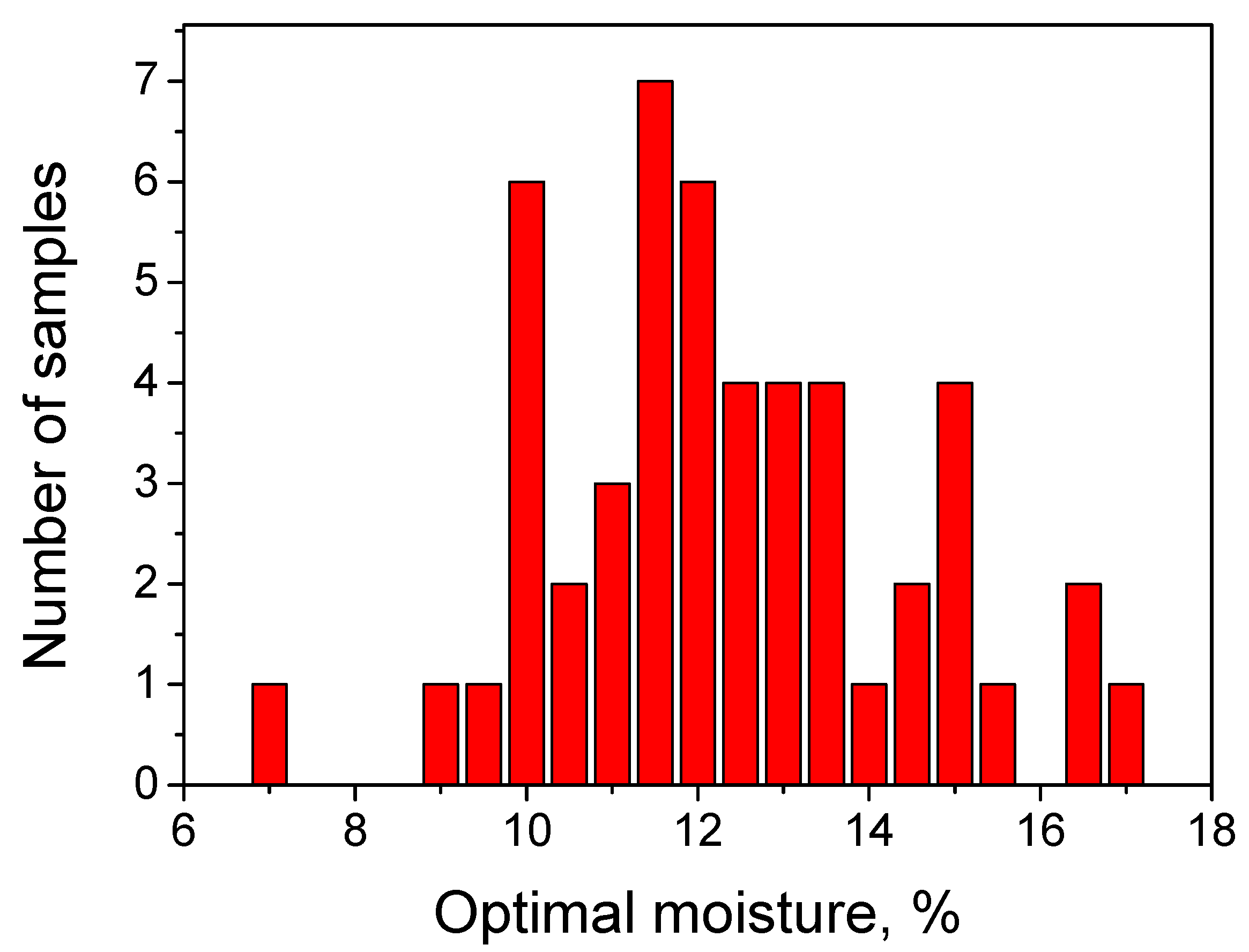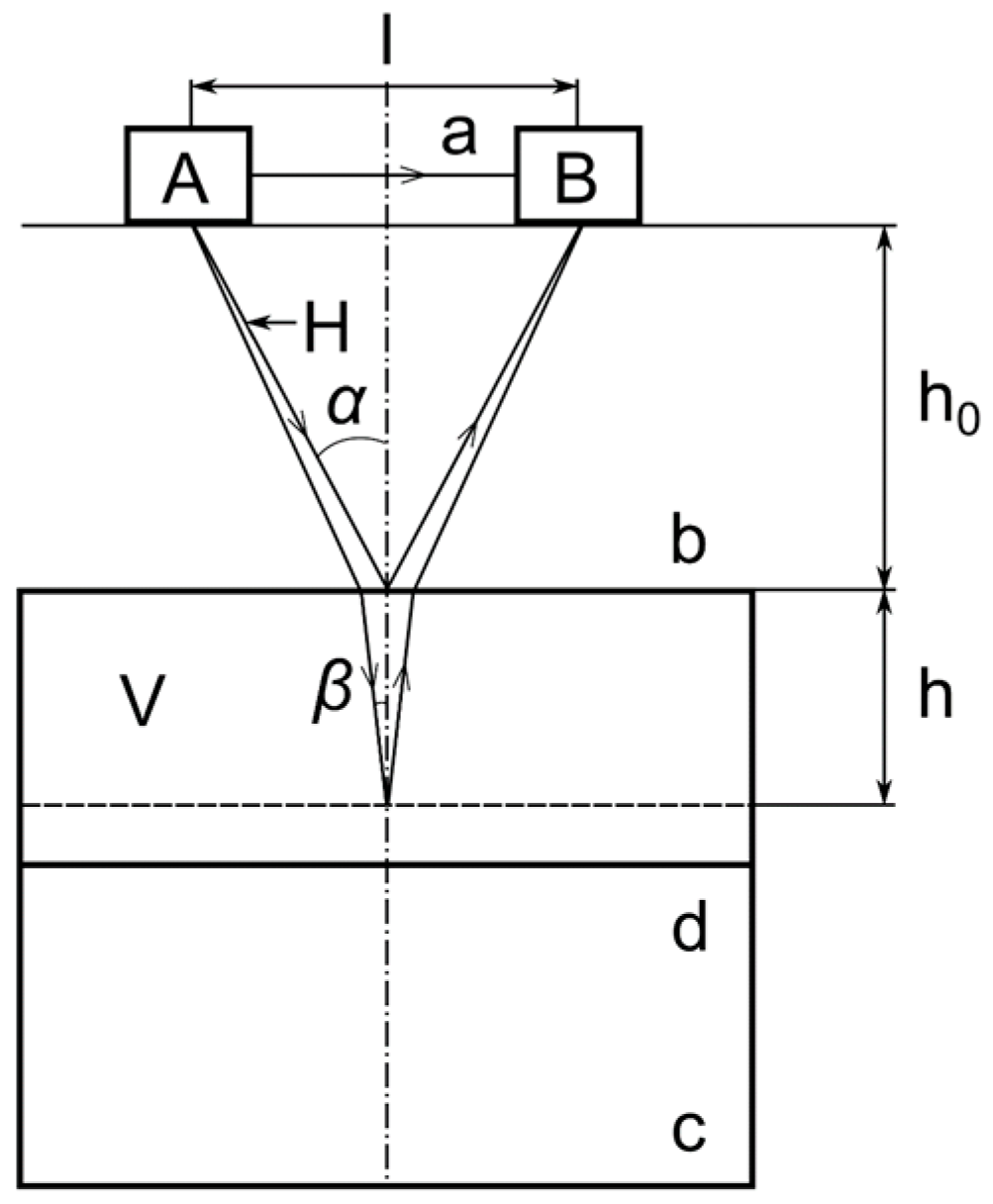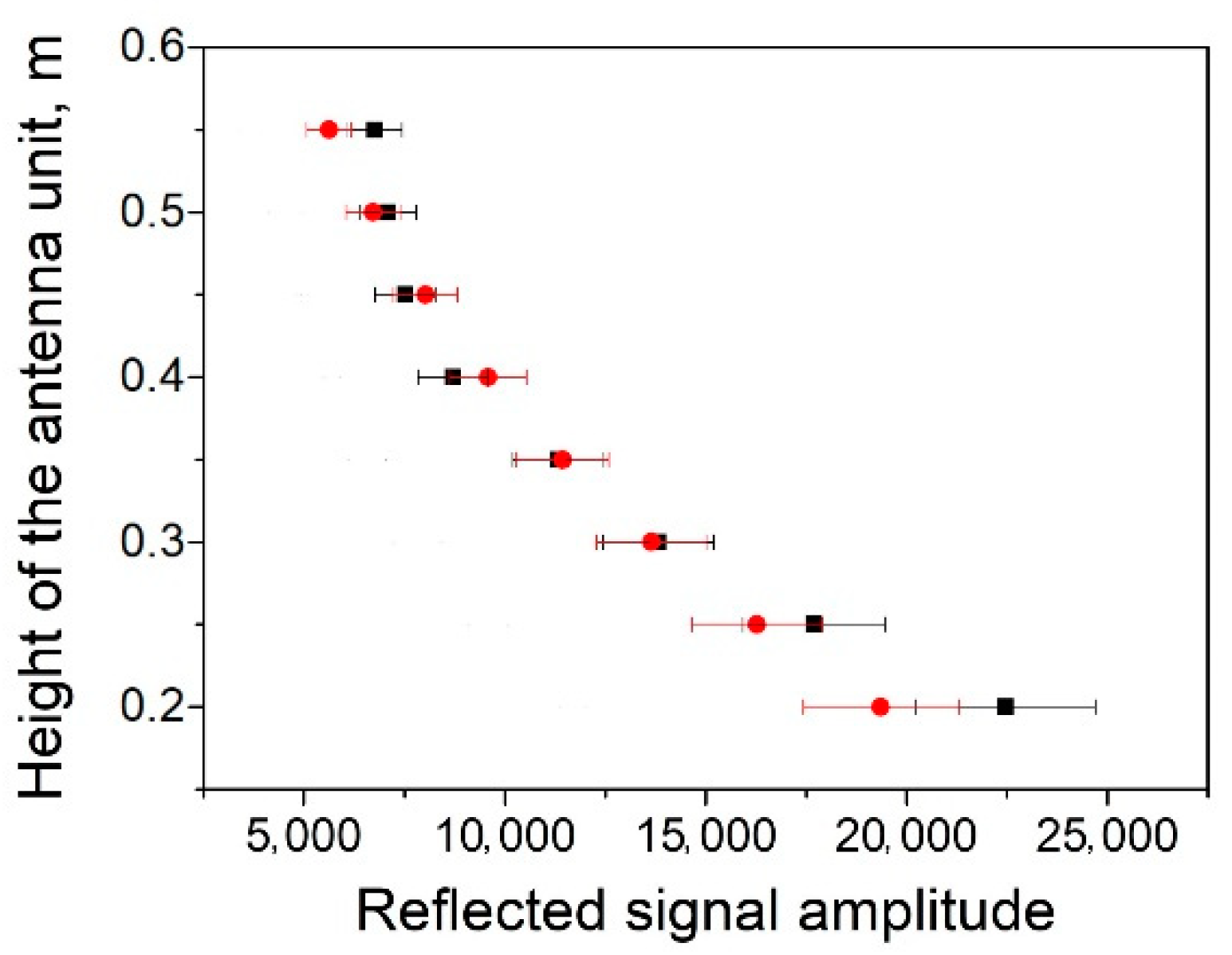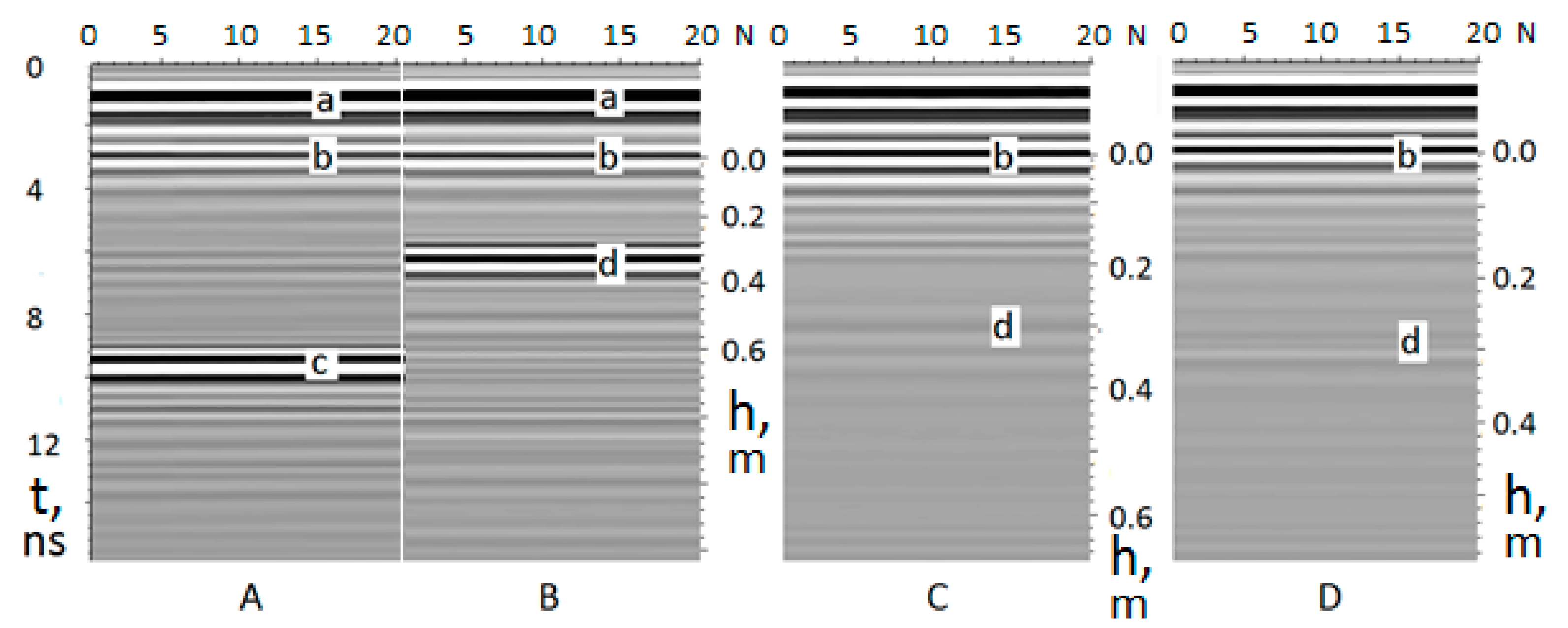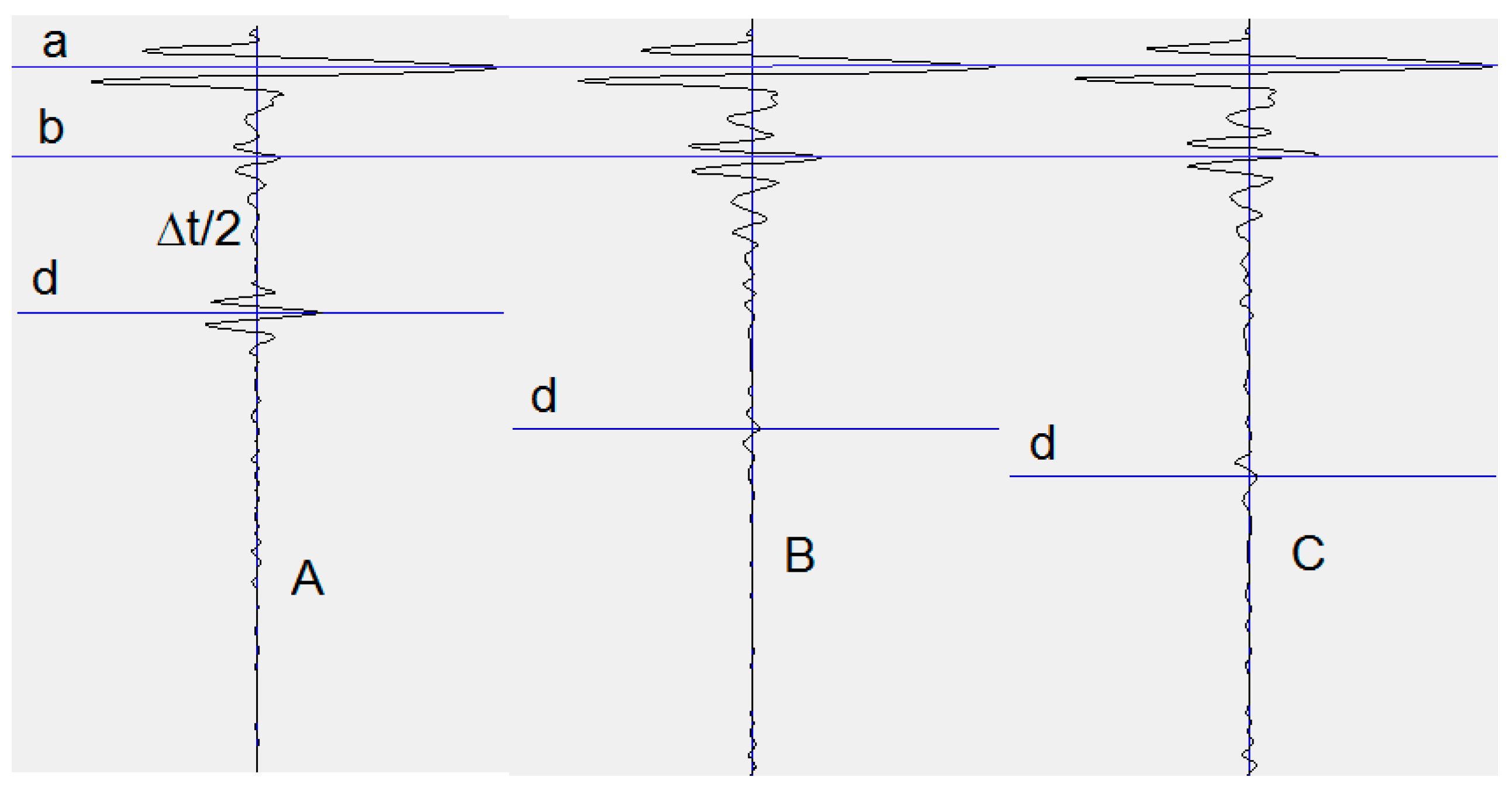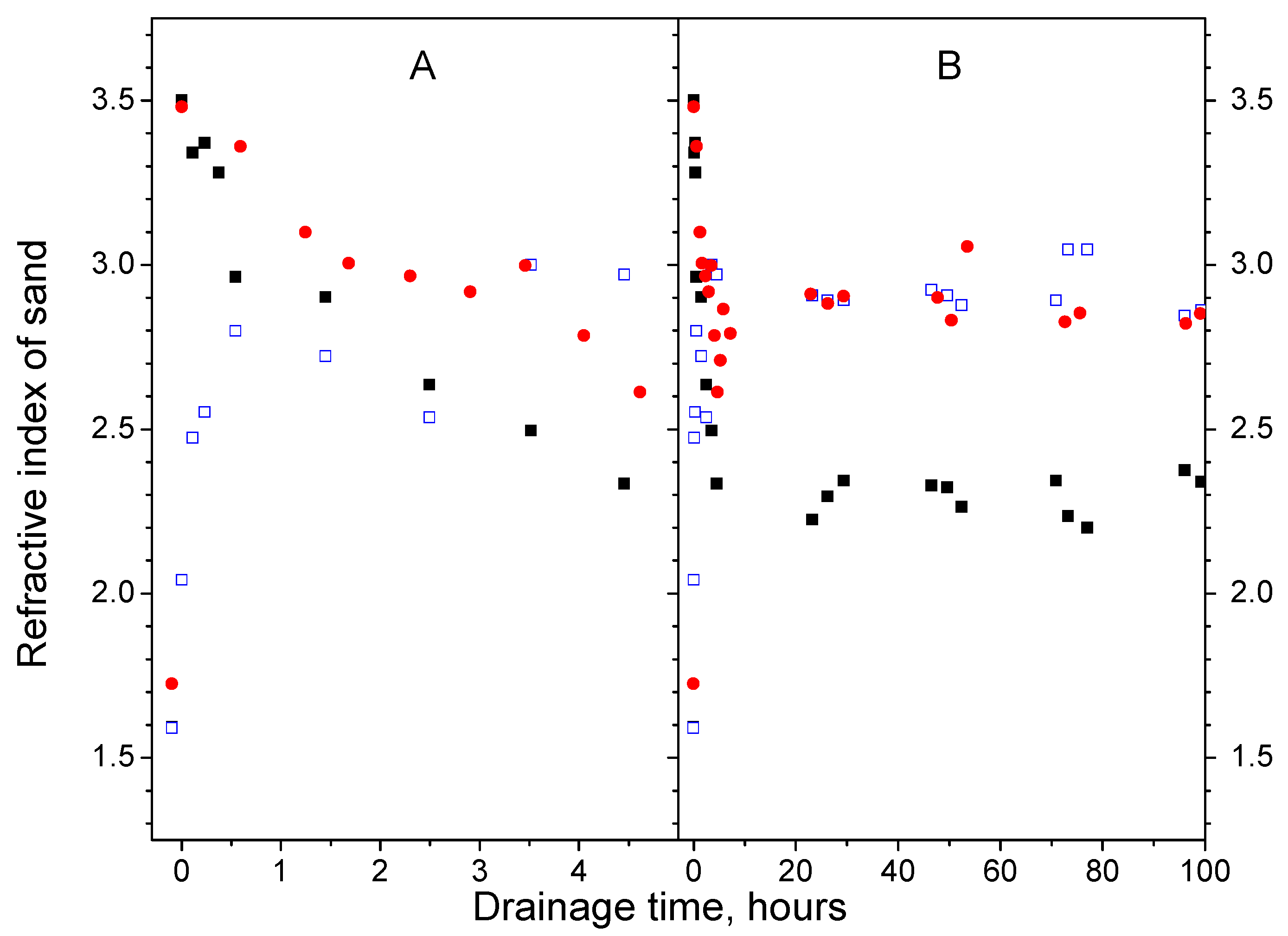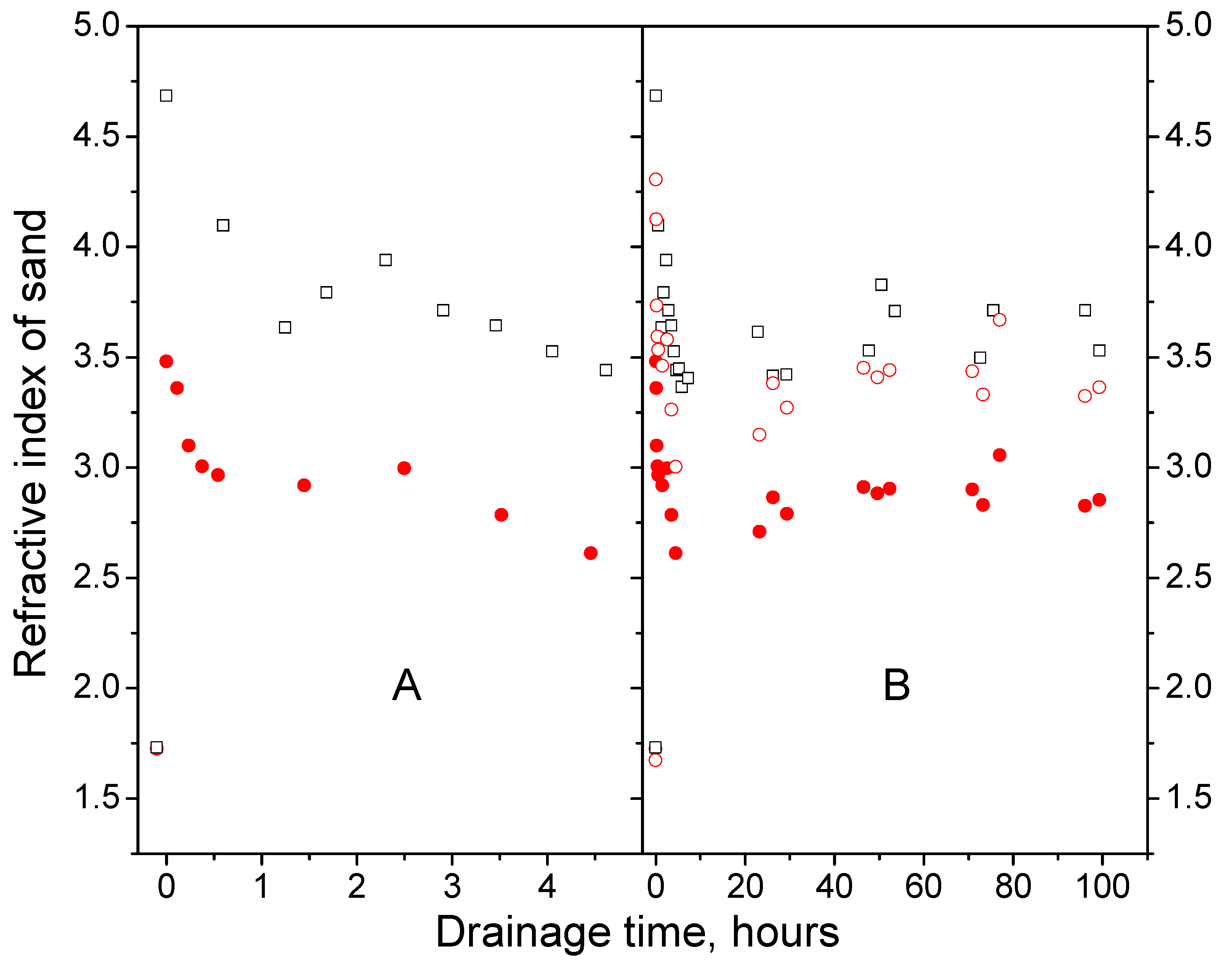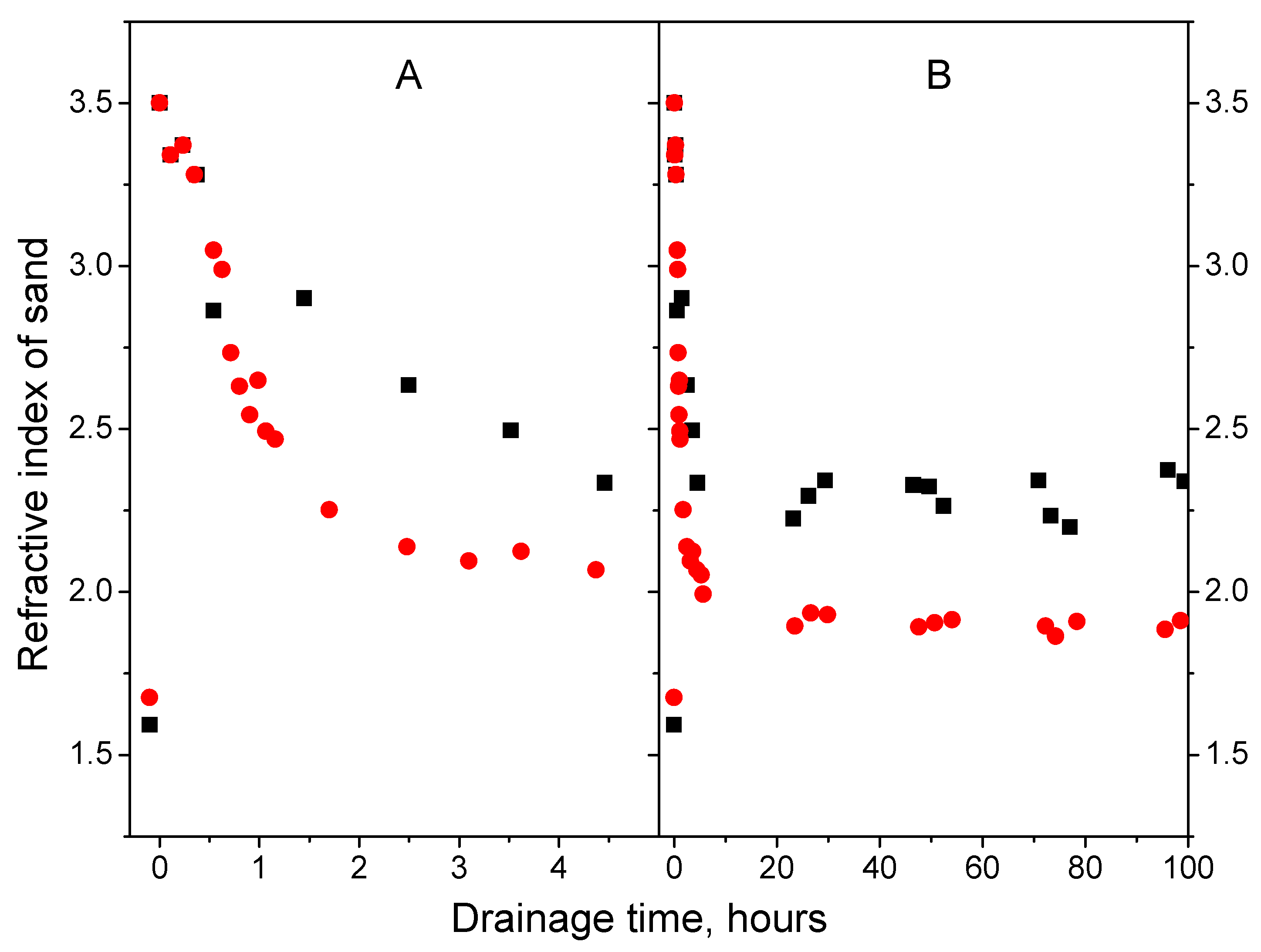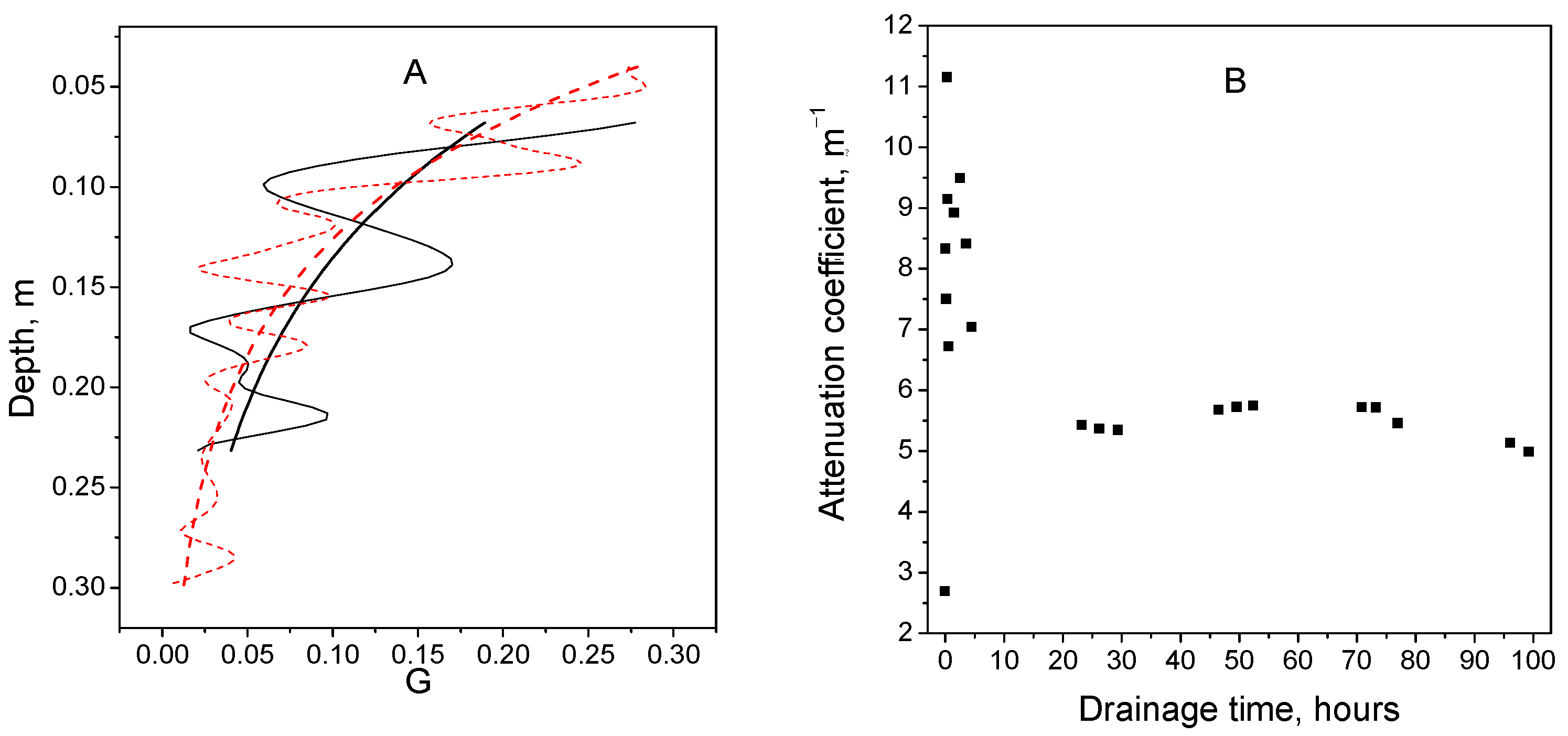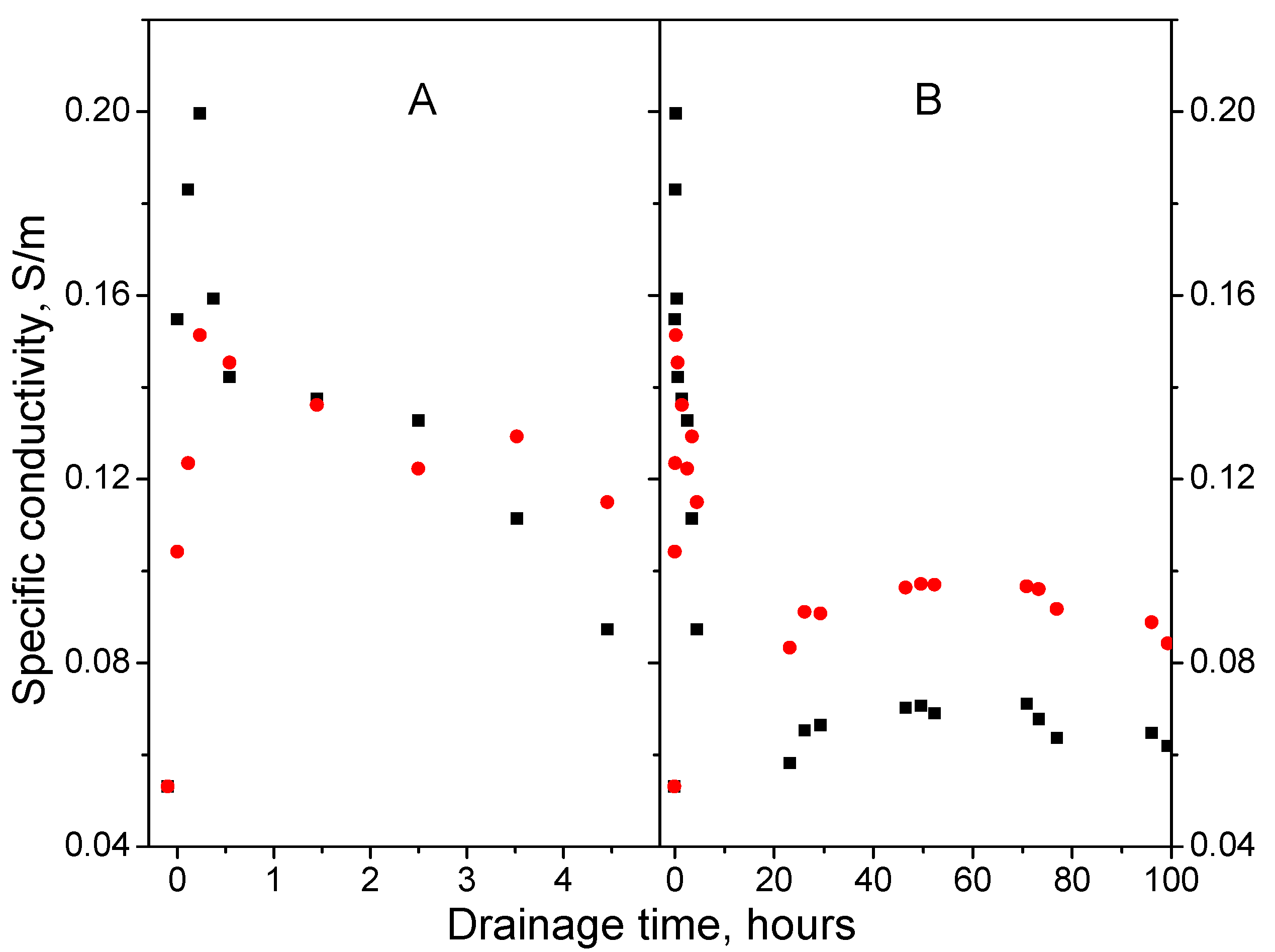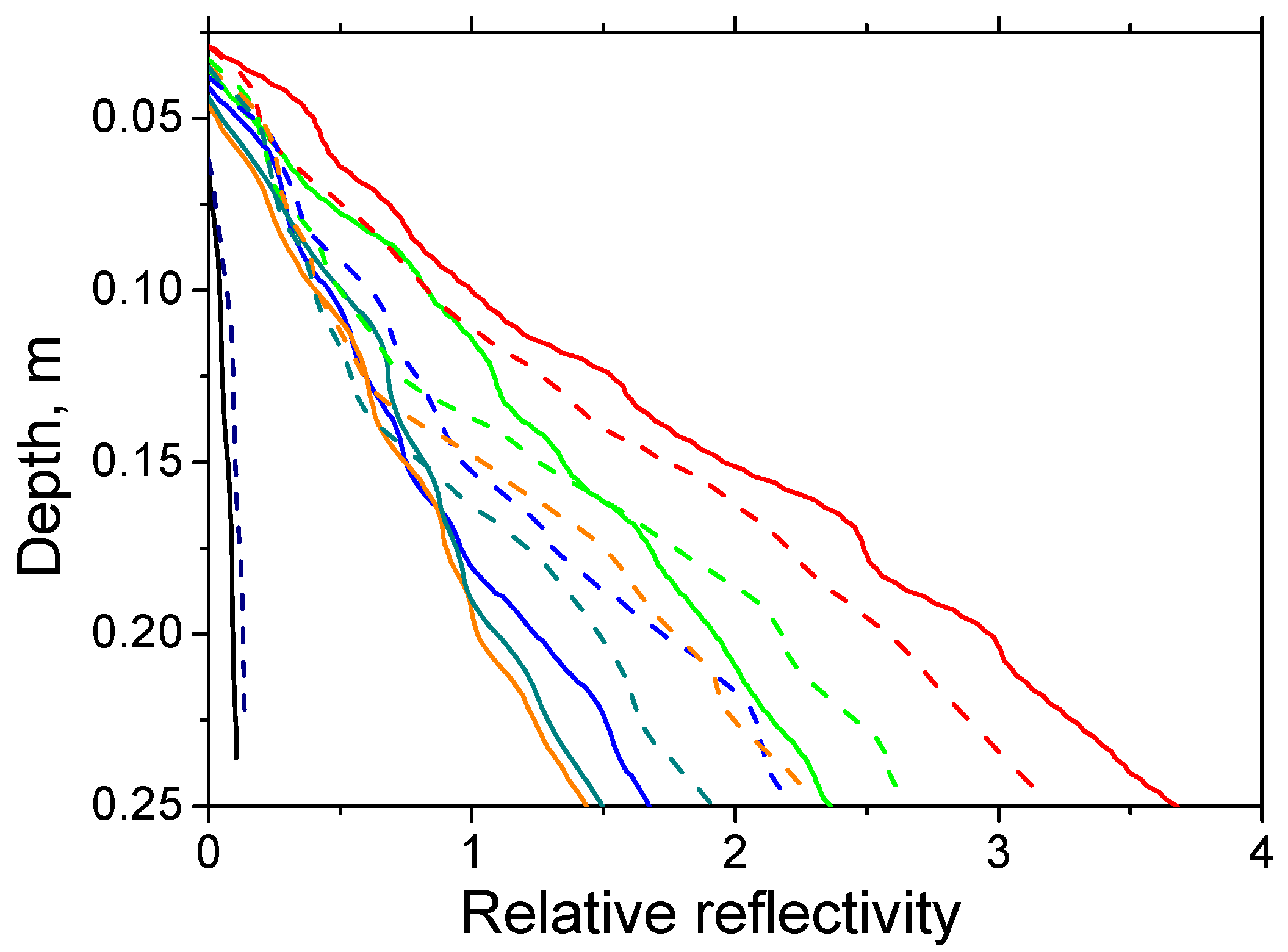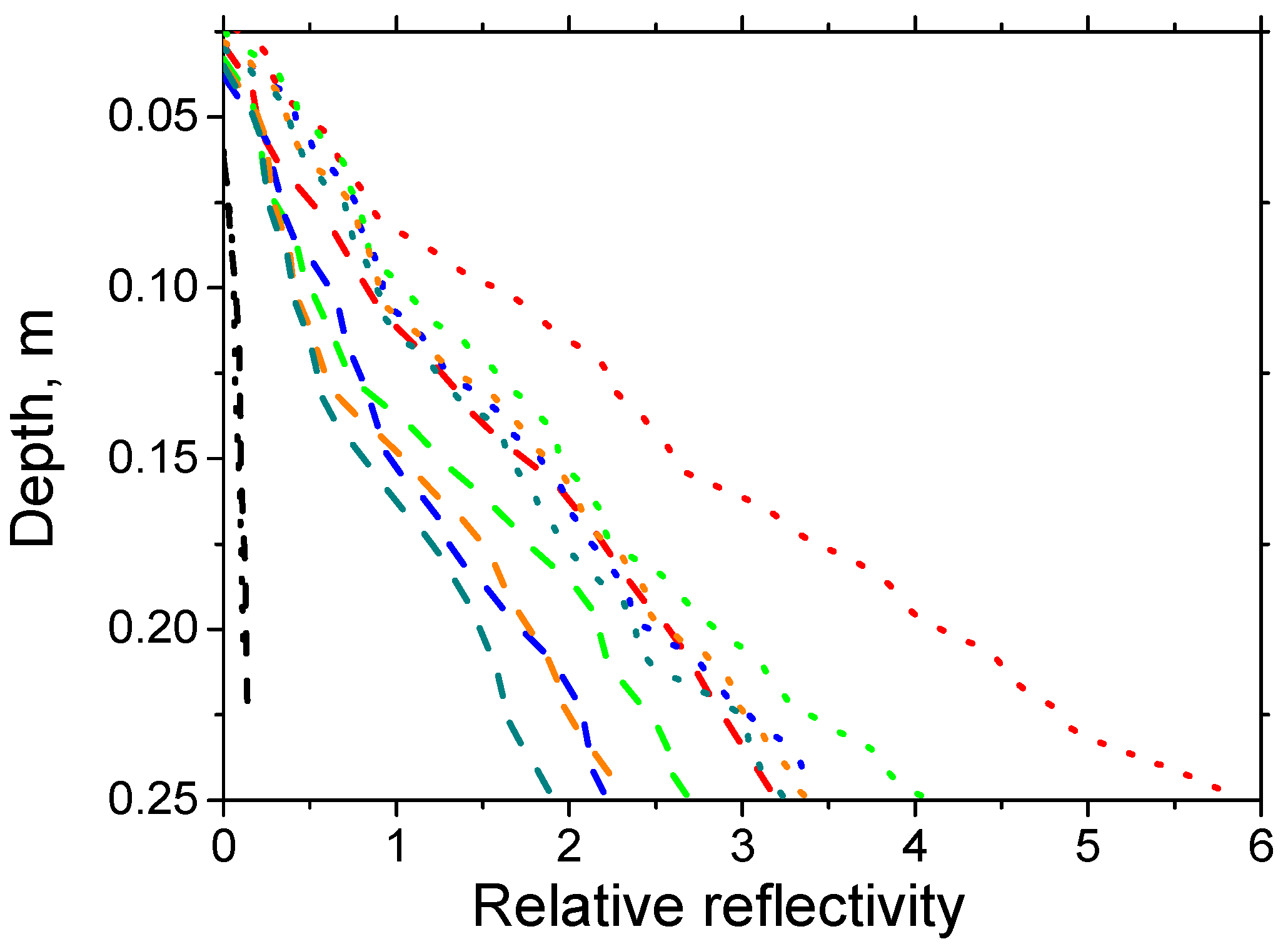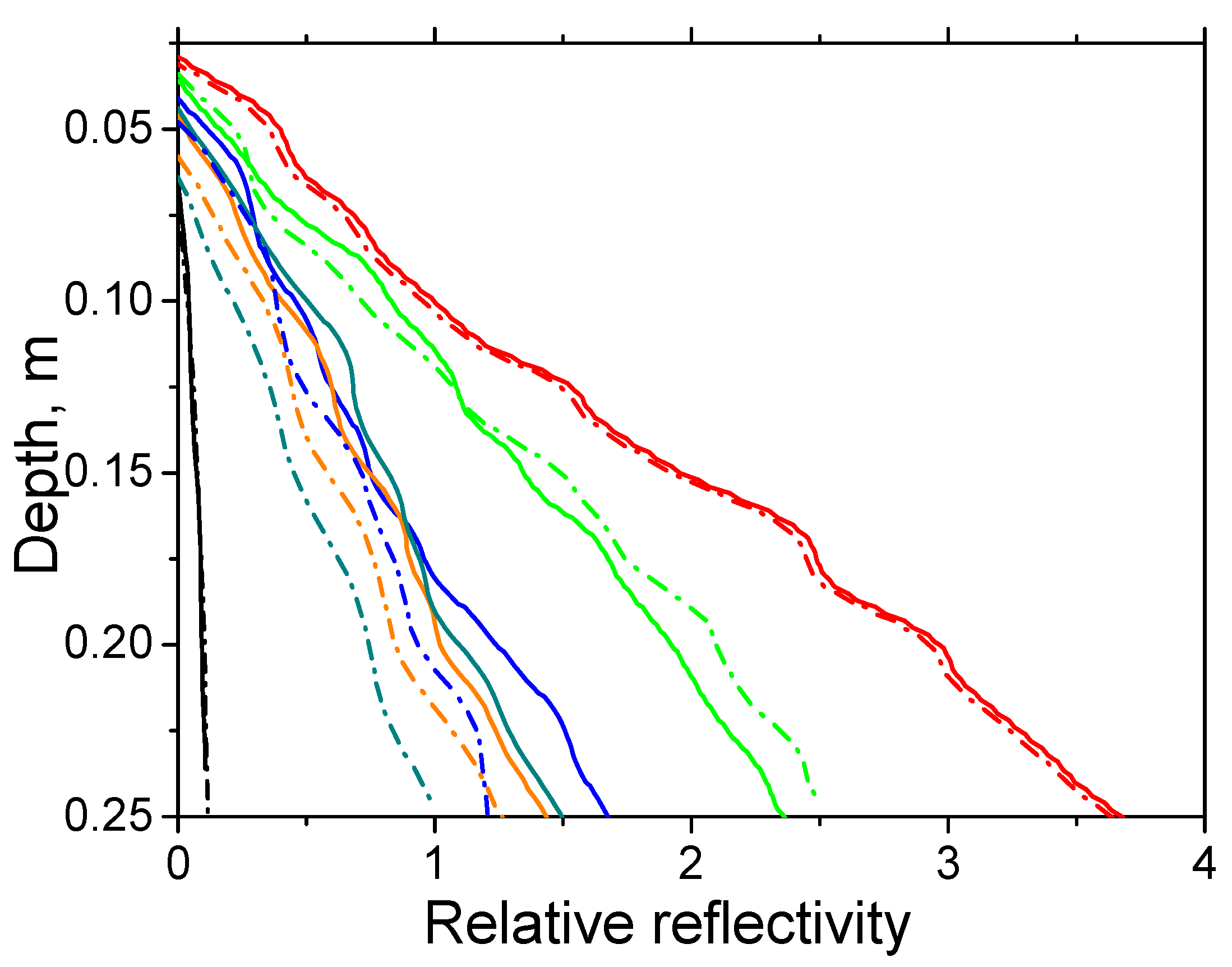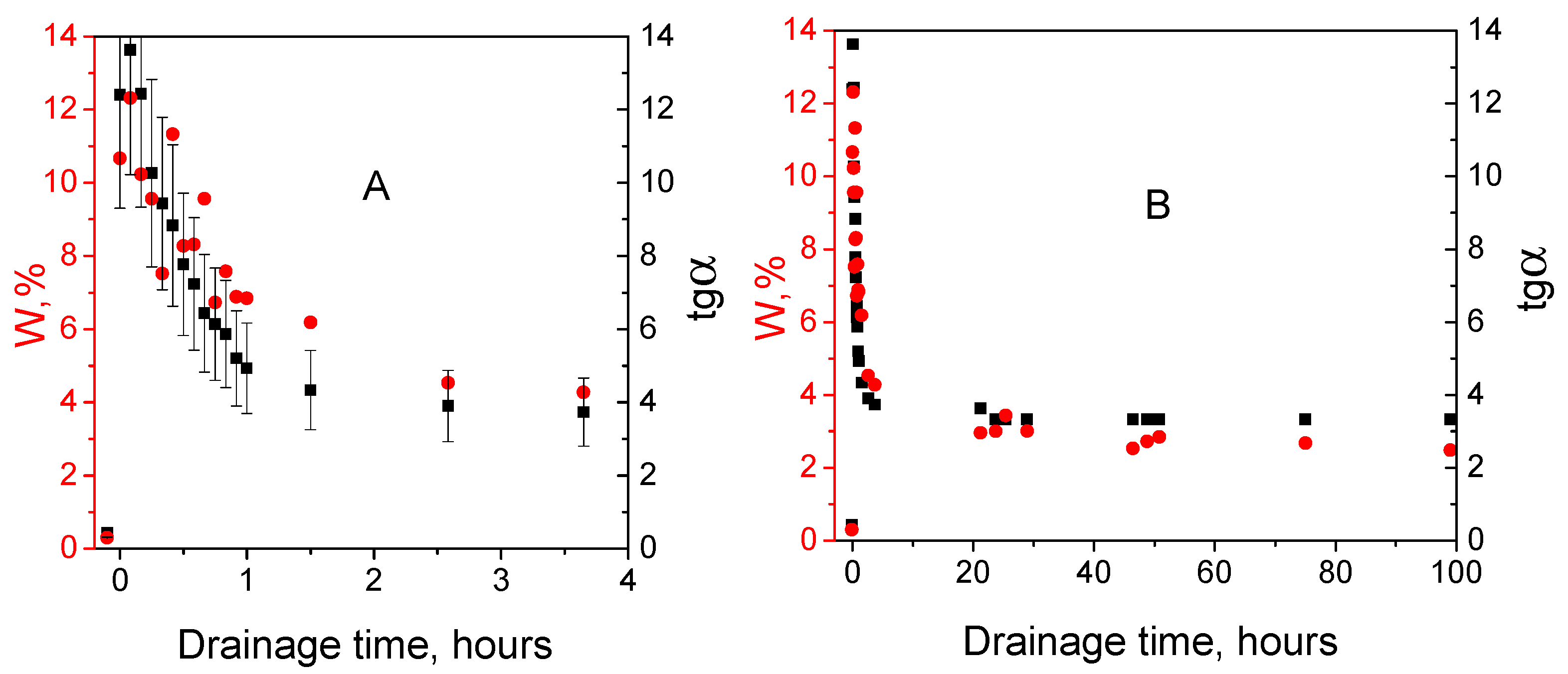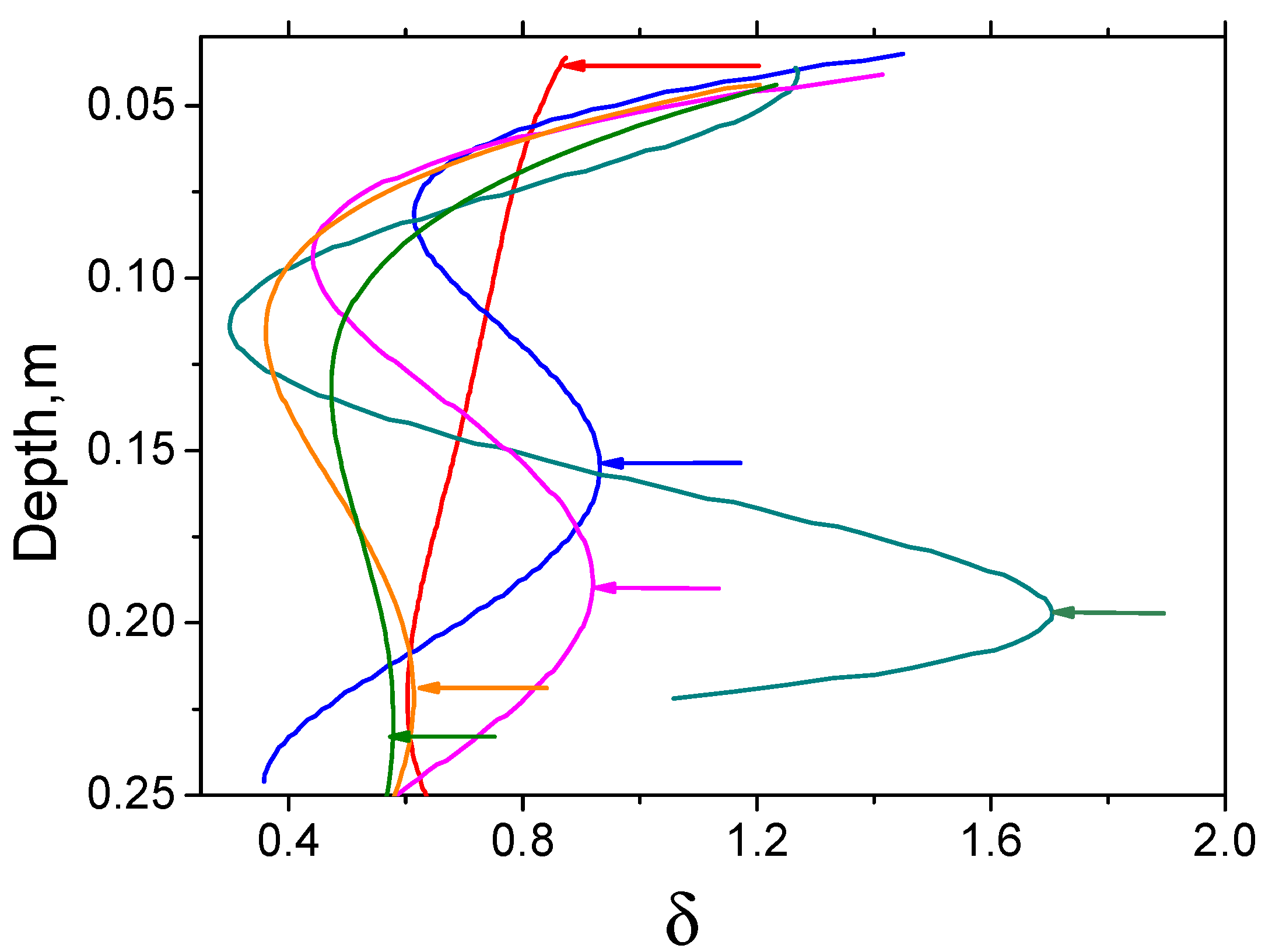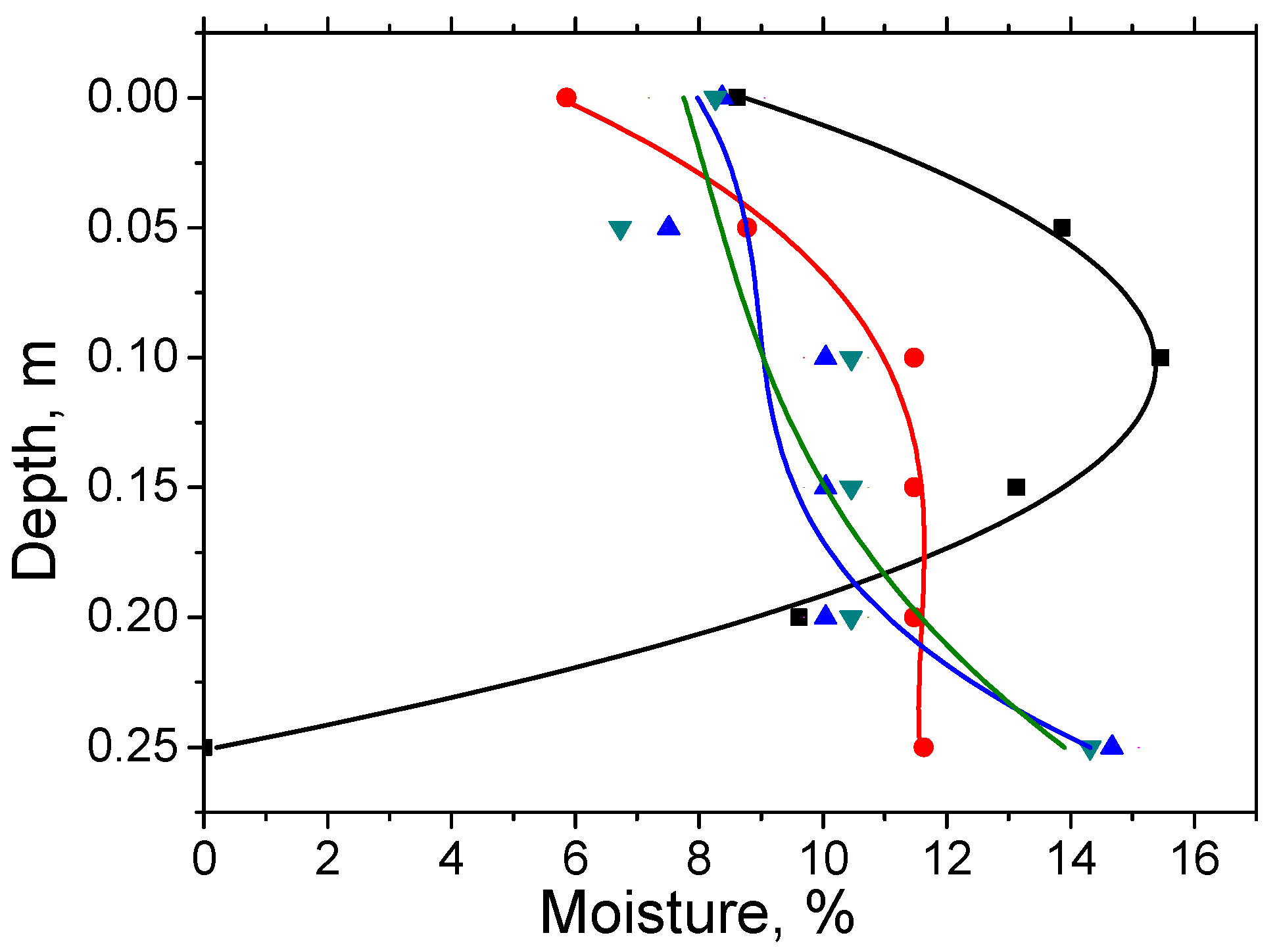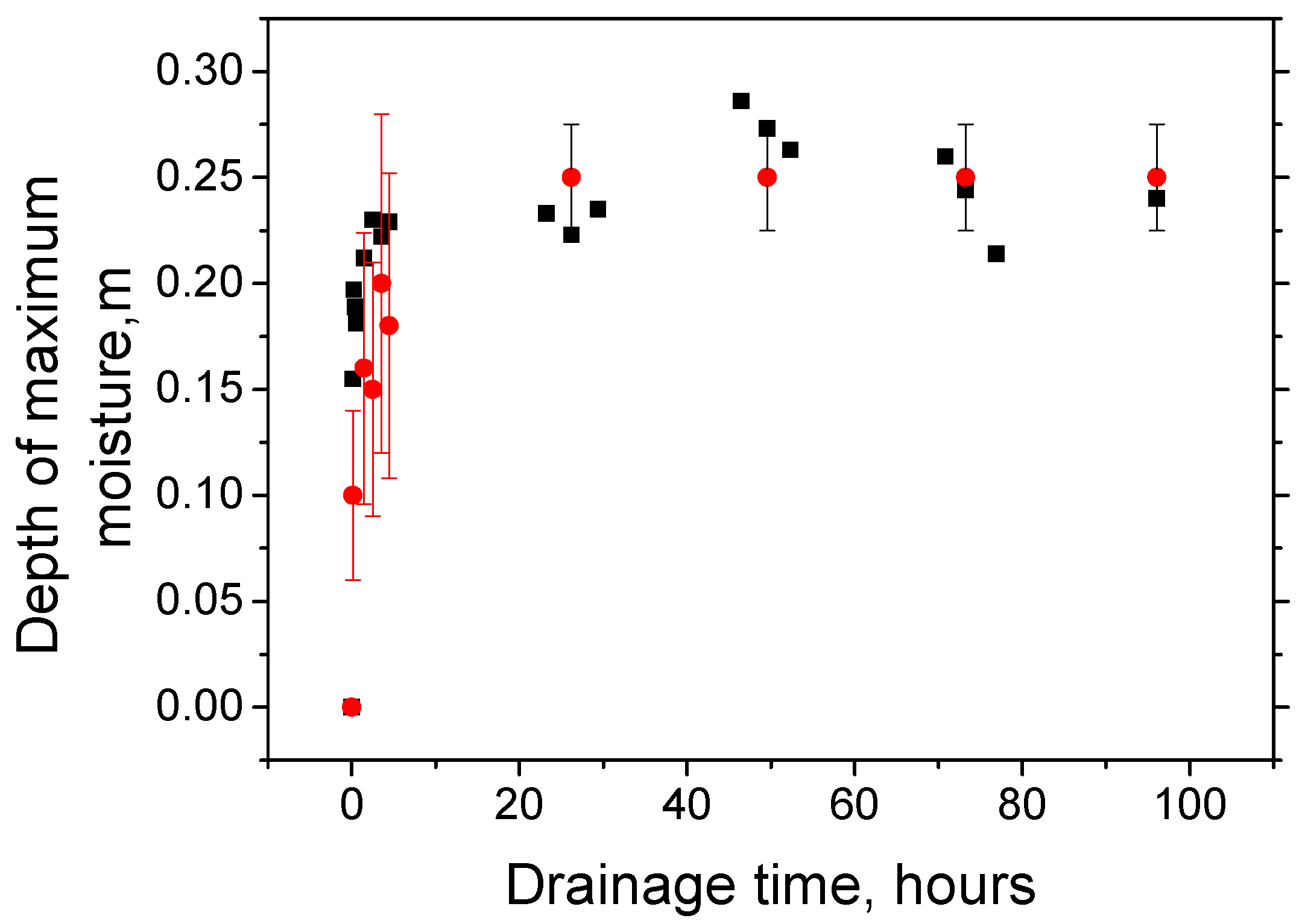5.1. Change in Refractive Index When Draining Water
Figure 5 shows the calculated dependence of the refractive index on the time of water drainage in experiments 1 and 2 determined by Equations (5) and (8).
In Equation (5), the amplitude of the signal reflected from the upper layer of sand is used. The reflected signal is formed in the upper layer of the sample [
28], the thickness of which in the selected frequency range and the observed range of refractive indices is several centimeters. Thus, Equation (5) gives the average value of the refractive index in the upper layer about 5 cm thick.
In Equation (8), the wave propagation to the lower boundary of the entire layer 0.3 m thick bounded by a waterproof partition and back is considered. Consequently, Equation (8) gives the average value of the refractive index of the sand in the entire layer.
Figure 5A shows that, immediately after moistening with the same amount of water, the refractive indices of samples No. 1 and 2 at the surface of the sand boundary calculated using Equation (5) are close and practically do not depend on the properties of the sand samples. As noted above, the reflected signal is formed in the upper layer of the sample several centimeters thick. In this layer, at the initial moments of drainage, the value of the refractive index is determined mainly by the refractive index of water, which in the used frequency range is noticeably higher than the refractive index of any dry sand. In this study, we used the value of the refractive index of water
determined by GPR measurements and Equation (5).
Let us interpret the results shown in
Figure 5. Consider the case of sand in a naturally dry state. We use Equation (16) and the experimental values of the refractive indices of samples No. 1 and 2, 1.59 and 1.73 (the first left points in
Figure 5, as well as the values of the porosity of the samples listed in
Table 1). As a result, we obtain the values
equal to 1.15 and 1.39.
The GPR measurements were accompanied by taking samples of moist sand with a hand soil sampler at a depth of 0.05–0.1 m and measuring their moisture content (
) using an MA100 moisture analyzer (
https://sartoros.ru/laboratory/, access date: 7 December 2022) equipped with an infrared heater which implements the formula
where
and
are the mass and density of the liquid phase, and
and
are the mass and density of the solid phase. For the volume portion of the liquid fraction, from Equation (17), one can get
The use of a hand sampler could cause additional sand compaction and lead to additional errors when determining the moisture. This mechanism for the emergence of errors was not analyzed in this work.
Direct measurement of moisture according to Equation (17) for samples No. 1 and 2 immediately after moistening and GPR measurements gave the values of 15% and 13%. Respective values of the volume proportions of the liquid fraction calculated by Equation (18) taking into account the data in
Table 1 turned out to be 0.27 and 0.21. These values, together with the results of measuring the porosity of the samples (
Table 1), made it possible to determine the volumetric content of the gas fraction
which turned out to be equal to 0.17 and 0.26, respectively. The performed measurements and numerical estimates made it possible to apply Equation (16) to the calculation of the refractive indices of the first and second samples immediately after moistening. The refractive indices were found to be 3.51 and 3.35. These values differ from the experimental ones by 3–5%.
During the drainage time of 30 h, the differences in the experimental refractive indices increase and stabilize for sand samples 1 and 2 at the values of 2.3 and 2.9. In this case, corresponding values of moisture content were 6% and 8%, and the values of volume fractions of the liquid fraction calculated by Equation (18), taking into account the data in
Table 1, turned out to be 0.10 and 0.12. The difference in these values can be explained by the manifestation of differences in the drainage properties of sands with the same amount of water used in the experiments 1 and 2. In this case, the values of the volume fractions of the gas fraction were determined to be 0.34 and 0.35, and the refractive indices for the first and second samples calculated by the Equation (16) turned out to be 2.30 and 2.71. In this case, the average difference between the calculated and experimental values of the refractive indices is about 5%.
Now, we can apply Equation (8) to determine the average value of the refractive index of the wetted layer after the completion of the drainage process. After 30 h of the moistening process, the experimental value of the refractive index of the sand is 2.89 (
Figure 5B). To estimate the average moisture content of a 0.3 m thick sand layer after the completion of the drainage process, in the first experiment, we take into account that the volume of water added to the sand is 15.1 L. This water creates, according to Equation (17), a moisture content of 8.5%. The volume fractions of the liquid (Equation (18)) and gas fractions of the first sample are 0.14 and 0.30, and the refractive index is 2.58. Comparison of the experimental and theoretical values shows their 10% difference.
Thus, the algorithms for processing GPR data make it possible to study the changes in the refractive indices of sands during water drainage with an error not exceeding 10%.
The effect of the volume of drainage water on the refractive index determined by Equation (5) is illustrated in
Figure 6, where the results of experiments 2 and 3 are compared.
It can be seen that an increase in the volume of drainage water from 15.1 L to 22.8 L leads to an increase in the refractive index. The average ratio of refractive indices determined from the data in
Figure 6 for experiments 3 and 2 is 1.21.
We can determine the theoretical value of the refractive index (
) in the third experiment using Equation (18). We assume that the volumetric water content in experiments 2 and 3 is proportional to the volume of water used for moistening. Then the volumetric water content in the third experiment can be determined from the relation
, where the indices number the experiments. In this case, the theoretical value of the refractive index in the third experiment is determined in the form
The results of calculation using Equation (19) are shown in
Figure 6B. Numerical estimates show that the theoretical values of the refractive indices in the third experiment exceed the values obtained in the second experiment by a factor of 1.19; this compares with the ratio of the experimental values with an accuracy of 2%.
Thus, the developed approach makes it possible to study the effect of the volume of drainage water on the value of the refractive index of sands.
The results of processing the GPR data obtained in experiments 1 and 4 are shown in
Figure 7.
Figure 7 shows that, at the initial moments of drainage, the refractive indices in experiments 1 and 4 coincide. As the water is drained in the absence of a waterproof partition in experiment 4, there is a general decrease in the refractive index in the near-surface layer ~0.05 m thick as compared to experiment 1.
5.2. Specific Conductivity
The use of Equation (11) for calculating specific conductivity implies, in addition to determining the refractive index, an independent determination of the attenuation coefficient of electromagnetic radiation in the soil layer. In this work, respective calculations are based on the use of Equations (9) and (10) for calculating the trace envelope and its approximation by an exponential dependence.
Figure 8A shows, as an example, the fragments of the GPR trace envelopes related to the soil layer before moistening and immediately after moistening with 15.1 L of technical water (experiment 1). The figure also shows the results of the approximation of these lines by exponential dependences obtained by minimizing the functional Equation (10).
In this work, similar calculations of the attenuation coefficients are performed for all GPR measurements using the developed computer program. The calculation results for experiment 1 are shown in
Figure 8B. It can be seen that the attenuation coefficient of wet sand at the initial moment of time exceeds the attenuation coefficient of dry sand by about four times. As the water is drained, the difference decreases to by about two times.
The dependences of specific conductivity on water drainage time in experiment 1 calculated by Equation (11) are shown in
Figure 9. When analyzing the calculation results, it should be taken into account that the refractive index of the moistened sand can be calculated for the upper part of the layer (Equation (5)), and on average over the whole layer volume (Equation (8)). In this regard, according to the data in
Figure 9, it is possible to estimate the difference in the average conductivity of the layer and the conductivity in the layer’s upper part in the process of water drainage.
One should keep in mind that these results are of a qualitative nature since, despite the difference in the refractive indices calculated by Equation (5) (thin upper layer of sand) and Equation (8) (entire layer of sand), the attenuation coefficient of electromagnetic radiation used in Equation (11) was determined by the fragments of traces related to the entire layer and, therefore, is the average for the entire layer in both cases. The use of the data of experiment 1 averaged over the depth after 50 h after the start of drainage and Equation (1) allow us to estimate the ratio .
5.3. Relative Reflectivity
To assess the sensitivity of the relative reflectivity to the moisture content of the layer, in this study, the reflectivity was calculated using Equation (14) for all the experiments performed. When executing the numerical procedure, the summation in Equations (12) and (13) was started from the trace point k1 shifted from the upper boundary of the layer inward by the width at half maximum of the signal reflected by the upper boundary. The relative reflectivity f(h) is obtained by summing under the condition
Figure 10 shows the calculated relative reflectivities
f for experiments 1 and 2 differing in the samples of sand.
Figure 10 shows that, for dry and wet sands, the relative reflectivity is a function of depth close to linear. For dry sands, the plot of this dependence has a very small slope; this means that relative reflectivity of dry sand is practically constant over depth and rather small. This behavior is explained by the fact that, according to Equation (14), the calculated value of
does not depend on the trace amplitude and changes slowly with
, which reflects the slow attenuation of electromagnetic waves in dry sands. The closeness of the results for samples No. 1 and 2 is explained by the closeness of their electrophysical parameters in the naturally dry state.
Moistening the samples No. 1 and 2 with water in a volume of 15.1 L leads to an increase in the amplitude of the reflected wave in areas with a nonzero gradient of the refractive index (Equation (4)) and related growth of
. This leads to an increase in the slope of the dependences
f(
h) reaching maximum immediately after the sand layer is moistened (red lines in
Figure 10). As the drainage proceeds, the moisture content of the upper layers decreases. This causes a decrease in
f(
h) and the tangent of the angle to the depth axis. As follows from
Table 1, the filtration coefficient for sample No. 1 is greater than that for sample No. 2; this explains the faster decrease in the slope of the graphs of relative reflectivity of sample 1.
Figure 11 compares relative reflectivities
f(
h) calculated for experiments 2 and 3, in which the sample of sand No. 2 was moistened with 15.1 and 23.8 L of water, respectively.
Figure 11 shows that, for dry and wet sands, the relative reflectivity is a function of depth close to linear, and it has a very small slope, as in the previous case (
Figure 10).
An increase in the volume of water used for moistening leads to a noticeable increase in the slope of the graphs of relative reflectivity relatively to the depth axis (red lines). This can be explained by the fact that, with an increase in the volume of moistening water, the gradients of the refractive index and the amplitude of the reflected wave increase (Equation (4)), which causes an increase in and an increase in the tangent of the slope of the dependences to the depth axis.
Since the water does not leave the 0.30 m thick layer during drainage, the termination of the drainage process in experiment 3 is characterized by higher values of the slopes of the graphs of relative reflectivity than in experiment 2. The validity of this conclusion is confirmed by the data shown in
Figure 12, which compares relative reflectivities determined in experiments 1 and 4 with moistening the layers of sand sample No. 1 0.30 and 0.60 m thick with water in a volume of 15.1 L. It can be seen that, at the beginning of the drainage process, the values of relative reflectivity in these experiments are close. However, as water drainage continues in experiment 4, smaller values of
are achieved, resulting in a smaller tangent of the slope of the graphs
f(
h) to the depth axis, since the moisture value in this case is less due to partial water drainage below the mark of 0.30 m.
Figure 13 directly compares the measured moisture content of the thin near-surface sand layer with a thickness of 0.05 m (
W) and calculated tangent of the slope of the graph
f(
h) (tan
α =
) determined in experiment 4.
Figure 13 shows that tanα first decreases rapidly; however, as the drainage time increases, it stabilizes. To analyze the results obtained, we assume that the dependence of relative reflectivity
f on depth
h is approximated with sufficient accuracy by a linear law during the first hour of drainage:
where
is the value of the relative reflectivity at the upper boundary of the layer, and
α is the angle of slope of the reflectivity graph to the depth axis.
Note that relative reflectivity is proportional to the amplitude of the reflected wave. From Equations (4) and (16), it is possible to obtain the dependence of the change in amplitude in time on the volumetric moisture content of the sample:
Then, the change in tan
α in time is determined by the relation
or, taking into account Equation (18),
Since in the case under consideration, during the first hour of water drainage, the moisture content of the sand changed by 10% and its average value was 9%, the change in the slope tangent with time can be estimated, according to Equation (23), as 11%. A rigorous calculation of the Pearson correlation coefficient leads to a value of 0.916. According to the Chaddock scale, such a value characterizes the correlation as ‘very high (strong)’. In this case, the average value of the relative error in the values of moisture and the tangent of the angle of inclination is 20%.
The process of water draining from top to bottom can be characterized by a time-dependent distribution of moisture in depth. The boundaries of areas with different moisture are the sources of reflected electromagnetic waves. In this regard, the relative reflectivity should carry information about such areas. To analyze this mechanism, we abandon the linear approximation (Equation (20)) and calculate the derivative of the relative reflectivity (Equation (15)). In this study, using software methods, the derivative calculation procedure is supplemented by the approximation of the calculation results by a fifth-degree polynomial.
Figure 14 shows the graphs of the fragments of polynomials approximating the dependences
.
Figure 14 shows that the derivative of the relative reflectivity with respect to depth immediately after soaking has a local maximum at a depth of 0.025 m and slowly decreases with increasing depth. This is explained by the fact that the GPR studies were carried out immediately after sand moistening, when water displaces the gas fraction to a depth of 0.025 m. After 0.1 h of drainage, at a depth of 0.15 m, a local maximum is formed, associated with the lower boundary of the moistened sand and the resulting anomalous reflection of electromagnetic waves due to the refractive index gradient (Equation (4)). During the first hour, the local maximum shifts to depths of up to 0.2 m. With increasing drainage time, this process continues, but at a noticeably slower rate, since the mass of draining water decreases, and the gas fraction near the bottom of the sand layer is displaced.
To search for areas with maximum moisture during experiment 1 at depths of 0.05 m, 0.1 m, 0.15 m, 0.2 m, and 0.25 m, the moisture was determined by non-GPR direct methods after performing GPR experiments. Directly measured moisture values were approximated by third-degree polynomials. The results of some measurements and their approximation are shown in
Figure 15. The depths with the maximum moisture content were determined as the maxima of the approximating curves.
Figure 15 shows that, after moistening and GPR measurements, the maximum moisture is fixed at a depth of 0.1 m, while the line corresponding in time to drainage in
Figure 14 has a local extremum at a depth of 0.025 m. This apparent discrepancy is due to the fact that sand sampling for the direct moisture measurement was carried out a few minutes after the GPR measurements. As time increases, the region of maximum moisture shifts to greater depths, and, after a while, drainage stops. The profile of the corresponding stationary lines (
Figure 15, blue and green) during vertical gravity drainage is determined by surface tension forces and sand properties. At the same time, the moistening of the sand in the upper part of the layer is preserved. The respective moisture content is 6–8% and is explained by the compensation of gravity by surface tension with incomplete replacement of the gas fraction.
In
Figure 16, the depths with the maximum moisture contents are compared with the depths of the maximum values of derivative of relative reflectivity (Equation (15)). The given data demonstrate a gradually slowing down movement of the maximum moisture front into the depth of the naturally dry sandy layer during the first 3–5 h from the start of drainage. Then, at a depth of 0.25 m, for experiment 1, this movement stops.
Figure 16 shows that the theory qualitatively reproduces the process of water drainage through the sand layer. A rigorous calculation of the Pearson correlation coefficient leads to a value of 0.907. In accordance with the Chaddock scale, such a value characterizes the correlation as ‘very high (strong)’. The quantitative difference of theory and experiment on the interval of the first 5 h of drainage is estimated to be 40%. This may be due to the fact that the sand samples for moisture measurements were taken near the side surfaces of the volume, which, as can be seen from
Figure 16, were constantly moistened more slowly. This procedure for sampling sand is caused by a reluctance to deform the central zone of the volume, which mainly forms radargrams during normal incidence of an electromagnetic wave. After 20 h of the experiment, drainage in the vertical and horizontal directions stopped. In this case, the difference between the theory and the results of direct moisture measurement is stabilized at 10%.
